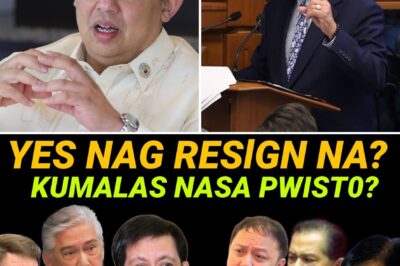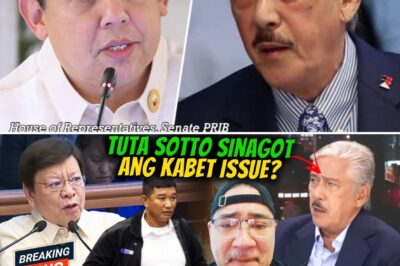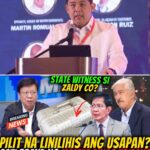
In the wake of Typhoon Tino, as rescue workers wade through the mud and grief of Cebu, a horrific body count emerges: 188 dead, 135 missing. For many, this is not just a natural disaster. It is a mass casualty event, a crime scene where the evidence isn’t a weapon, but the very infrastructure designed to protect them.
As the nation reels, Senator Rodante Marcoleta has launched a blistering offensive, not just against the storm, but against what he describes as a deeply entrenched “grand design” of corruption and cover-up that, he alleges, led directly to the catastrophic loss of life. The senator claims the catastrophic flooding wasn’t just inevitable; it was facilitated by ghost projects, substandard materials, and a political machine more interested in protecting its “masterminds” than its citizens.
The central, horrifying allegation that has captured the public’s fury is the claim of phantom engineering. According to reports cited by the commentary, the flood control projects that crumbled under Tino’s deluge were not just poorly designed; they were allegedly fraudulent. “Alam mo yung pinadala sa aking isang litrato,” one of the hosts stated, “Kahit papaano kong tingnan hindi bakal yun eh… Parang plastic pipe.”
The suggestion is unthinkable: that in projects designed to hold back raging torrents, contractors used flimsy plastic pipes in place of steel reinforcing bars (rebar). It’s an allegation that, if true, transforms these projects from failed infrastructure into meticulously constructed death traps. The communities, believing they were protected, were instead living next to ticking time bombs.
“The purpose of a flood control project is to protect the community,” Senator Marcoleta argued, his voice heavy with indignation. “But what happened was the opposite.”
This is where the tragedy pivots into a dark political thriller. Marcoleta and his colleagues allege that even before the floodwaters had receded, a coordinated cover-up was underway. They accuse powerful, unnamed figures of attempting to divert the public’s gaze, blaming the disaster on “dolomite projects” or other peripheral issues—anything to avoid looking at the failed flood controls and the politicians who funded them.
“Nature itself is exposing the truth,” the host declared, suggesting that the scale of the disaster has made the corruption impossible to hide.
The government, in their narrative, is not a rescuer but an adversary. As an even more powerful storm, “Super Typhoon Uwan,” barrels toward the Philippines, the hosts offered a chilling warning to the public: “You can’t rely on this government. You are on your own.” They urged citizens in Northern and Central Luzon to prepare, to evacuate, and to save themselves, painting a grim picture of a “useless” administration that, they allege, has already stolen the money that was supposed to keep them safe.
But the senator’s most explosive claims center on the investigation itself. How, he asks, can the truth be uncovered when the entire system is designed to silence those who speak it?
He points to the case of the Independent Commission on Investigation (ICI), which, through its chairperson, retired Justice Andres Reyes Jr., has publicly stated its difficulty in connecting DPWH officials to the “proponents”—the politicians or congressmen who allegedly mastermind the schemes. The ICI has called for whistleblowers to come forward.
For Marcoleta, this is the height of hypocrisy. He claims he has been demanding the use of whistleblowers from the beginning, citing the Discaya couple, but was obstructed by political rivals (heavily implying Ping Lacson) who, he suggests, were trying to protect the ultimate mastermind.
This brings the story to Sergeant Orle Gutesa. Gutesa is the whistleblower who delivered bombshell testimony, claiming he personally delivered “maleta” (suitcases) brimming with cash. Instead of being hailed as a hero, Gutesa was, in Marcoleta’s words, persecuted. The system, rather than investigating the delivery of illicit cash, focused on a technicality: an allegedly forged notary stamp on his affidavit.
“They are not interested in who the mastermind is,” Marcoleta fumed. “They will do everything to discourage people from coming forward. They even questioned the brand of the suitcase!”
The senator claims this “notary” issue is a deliberate smokescreen to invalidate the testimony. He argues that in the “real world,” it is common practice for a lawyer’s staff to sign notary documents on their behalf. To prove this, Marcoleta says he took his investigation to the courts—and hit a brick wall.
In a stunning allegation, Marcoleta claims a Manila judge actively obstructed his attempt to gather evidence. He says he went to the judge not to contest the Gutesa signature, but to request comparative samples of other documents notarized by the same lawyer on the same day, which he believes would establish the “common practice” and prove the affidavit’s intent was genuine.
The judge, he claims, refused. Marcoleta says he then escalated his request to the Supreme Court, which allegedly granted it. However, he now accuses a lower Executive Judge of defying the Supreme Court’s order by insisting that she will be the one to “choose” which samples to provide—a move Marcoleta sees as a blatant attempt to cherry-pick evidence and continue the cover-up.
“They are weaponizing the law to protect the guilty,” he stated, vowing to fight the judge. “Try me. We will find out where you stand.”
The narrative being woven is one of a vast, multi-layered conspiracy. It involves corrupt contractors using plastic pipes, complicit DPWH officials, political “proponents” skimming billions, and a political “mastermind” so powerful that they can allegedly influence judges and discredit whistleblowers at will. Even the personal attacks against Marcoleta, such as questions about his wife’s unrelated position as an “independent director” on a bank board, are painted as desperate attempts by “them” to find leverage and silence him.
As Super Typhoon Uwan approaches, the country is holding its breath. The storm is not just a meteorological event; it is a test. It threatens to expose every single substandard, corruptly-built project that lines the country’s waterways. For the people of the Philippines, the message from their own commentators is terrifying: the walls are built of plastic, the system is complicit, and you are on your own.
News
Behind the call for a “Truth and Reconciliation Commission” stand two controversial figures, one a “former addict turned priest” and the other a known political operative. Their presence at the CBCP’s press conference has completely undermined the sincerity of the entire appeal.
The Uncomfortable Embrace of Power and Piety The political landscape in the Philippines is rarely without its seismic shocks,…
The legal battle is heating up as the House of Representatives decided to summon key agencies, including the DBM and DENR, to clarify the source and rationale of the P389 million expenditure.
Beyond the White Sand: The Contentious Necessity of the Dolomite Beach Project As the nation grappled with mounting challenges from…
“A true friend is hard to find.” While one former host burns bridges, veteran comedian Jimmy Santos is going viral for his cryptic statement on loyalty. Everyone knows who he’s talking about. After Anjo Yllana’s shocking accusations and subsequent retraction, industry insiders say no one will ever trust him with a secret again. He has shown his true colors, and his old friends are making their opinions known.
The Philippine entertainment world has been fractured for months, still reeling from the bitter corporate divorce that saw the legendary…
Mabigat na pasanin ang hatid ng Ombudsman na posibleng papanagutin si dating Speaker Romualdez, kasabay ng akusadong si Zaldico, dahil sa ‘gross inexcusable negligence’ sa pagtatalaga. Isipin mo, sa gitna ng bilyon-bilyong anomalya sa flood control, hindi lang ang mismong sangkot ang haharap sa kaso, kundi pati ang naglagay sa kanya sa puwesto!
Sa gitna ng lumalawak na kontrobersya at nag-aalab na galit ng publiko, muling nabuksan ang usapin tungkol sa “due process”…
The flood control scandal reignites as the Blue Ribbon Committee reopens its probe on November 14, but attention has been entirely diverted by a private gathering. Former Speaker Romualdez and Senate President Sotto chose to meet beforehand, leaving many to wonder what negotiations are taking place behind closed doors. The anticipated absence of one of the invited parties, combined with mounting talk of a ‘fix,’ is turning the upcoming hearing into a pressure cooker. Will the real evidence be brought to light, or will it be overshadowed by political agreements?
In a development that has sent political shockwaves and captured the attention of the entire nation, the Senate Blue Ribbon…
Fugitive o Freesdom? Ang pag-iwas ni Zaldico sa pag-uwi ay nagdulot ng pagtawa sa Senado, ngunit ang kanyang sitwasyon ay nagpapatunay na ang mga nagkakamal ng bilyun-bilyong pisong nakaw ay may kakayahang bumili ng kanilang kalayaan. Ang pahayag ng kanyang abogado na may banta sa buhay niya ay tila isang malinaw na palatandaan na handa siyang manatiling tulisan.
Ang Pulitika ng Pagprotekta: Isang Malalim na Pagbusisi sa Kontrobersiya ng Blue Ribbon Committee Ang pulitika sa Pilipinas ay muling…
End of content
No more pages to load












